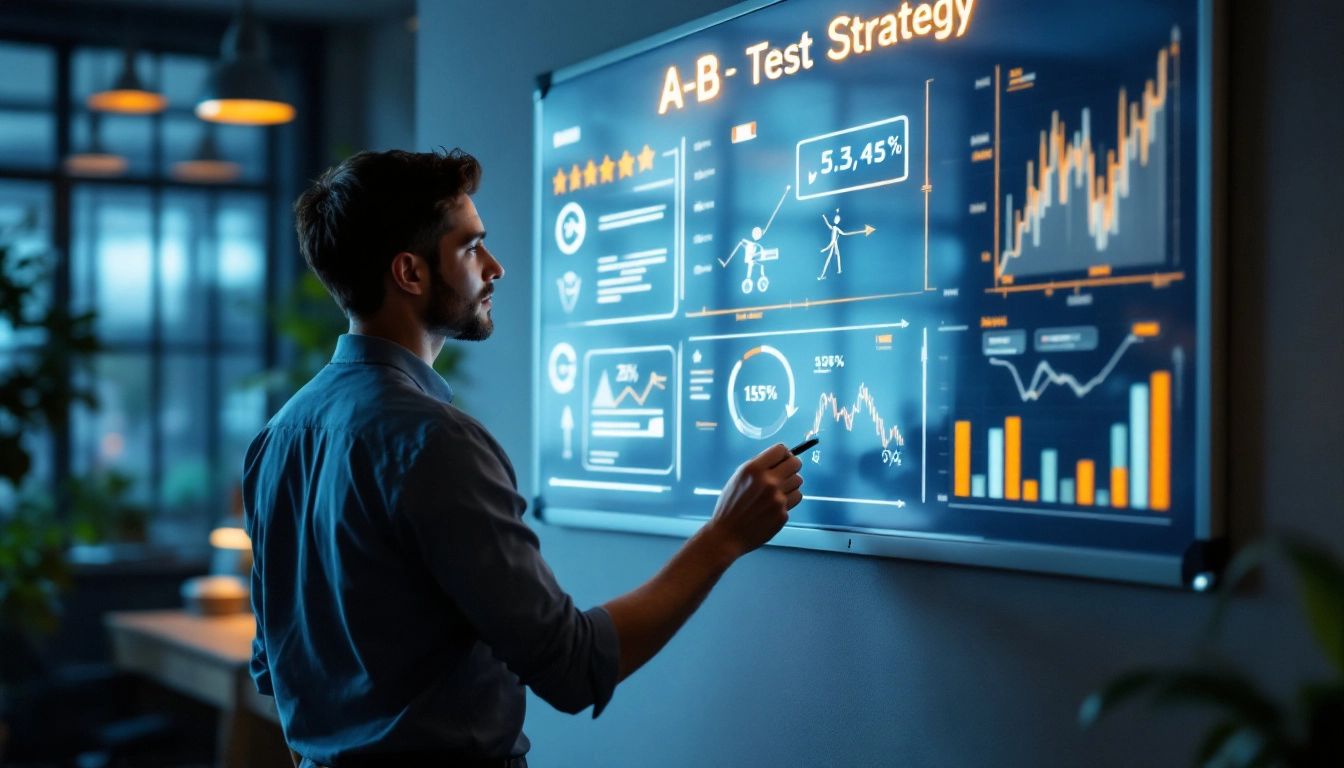A/B Testing Shopify: Boost Your Conversions with Data-Driven Decisions
November 6, 2024

Introduction to A/B Testing

You've launched your Shopify store and are ready to grow your sales. But how can you determine what truly connects with your customers? A/B testing, also known as split testing, offers a practical solution for optimizing your store and increasing conversions. It's a method of comparing two versions of a webpage, email, or other asset to identify the higher performer. Imagine it as a head-to-head comparison where the winning variation takes the lead.
Why is A/B Testing Important for Shopify?
In the competitive e-commerce world, every customer interaction matters. A/B testing on Shopify empowers you to make data-informed decisions, from homepage design to product descriptions. Instead of guessing, you can analyze actual user behavior to understand what works best for your audience. Something as seemingly minor as testing the color of your "Buy Now" button can significantly impact click-through rates. Perhaps a vibrant green button outperforms a classic red one – A/B testing provides the answer. Continuous testing and refinement allow you to optimize your store for maximum effectiveness and make the most of your current traffic. However, a sufficient volume of traffic is necessary for statistically sound results—aim for at least 250 to 500 purchases per variation to ensure reliable data.
How Does A/B Testing Work?
The process is simple: Identify an element you want to test, such as your product page layout or call to action text. Create two versions – A (the original) and B (the modified version). Show each version to a segment of your visitors, ensuring random distribution. Track metrics like conversion rates, revenue, and user engagement for each version over a period, typically one to two weeks (to account for business cycles and data accuracy). Analyze the results and choose the winner! The higher-performing version becomes the standard for your store. Remember to test only one variable at a time to pinpoint the source of any changes.
This A/B testing process for Shopify allows you to make decisions based on real user data, not intuition or assumptions. It's a continuous improvement cycle, enabling constant store optimization for better performance.
Setting Up A/B Tests in Shopify
Now that you understand the purpose and process of A/B testing, let's explore how to set up these tests in your Shopify store. While Shopify lacks a built-in A/B testing tool for all store elements, various apps and methods allow for effective testing, particularly for vital aspects like your online checkout process.
Choosing Your A/B Testing Method
Several options are available for A/B testing Shopify elements:
- Shopify App Store: The easiest route for most. Search for "A/B testing" to find apps with various features and prices. Some focus on product pages, others on checkout optimization. Prioritize apps with clear reporting, easy setup, and positive reviews. Checkout Links, for example, lets you A/B test checkout flows and simplify the purchase process for specific customer segments.
- Third-Party A/B Testing Platforms: Tools like Google Optimize and Optimizely offer more advanced features and integrate with Shopify. These are suitable for more complex testing needs or for testing across multiple marketing channels beyond your Shopify store.
- Manual A/B Testing (for simple tests): For basic tests, manually create two page versions and use Shopify analytics to track results. While more time-consuming and less accurate than dedicated tools, this can work for small-scale tests.
Implementing Your First A/B Test
Regardless of the chosen method, the basic setup is similar:
- Formulate a Hypothesis: What are you testing, and what outcome do you anticipate? For example, “Changing the ‘Add to Cart’ button from blue to orange will increase conversions.” A clear hypothesis keeps your tests focused.
- Choose a Single Variable: Test only one element at a time to isolate its impact.
- Create Your Variations: Implement the change on your "B" version, keeping "A" as your control. Ensure the changes are distinct for easy impact assessment.
- Split Your Traffic: Your chosen A/B testing tool will randomly assign visitors to either version A or B.
- Monitor and Analyze: Track metrics like conversion rates, revenue, and bounce rate. Allow at least a week, preferably two, to gather sufficient data and account for weekly traffic patterns. Remember that purchases, not just traffic, are key for statistically significant results.
- Declare a Winner: Analyze which version performed better after sufficient data collection. Avoid premature conclusions, as short durations can skew results. Confirm statistical significance before implementing changes.
- Iterate and Improve: A/B testing is continuous. Use your findings to inform future tests and continuously optimize your store. Small changes can accumulate over time, leading to substantial improvements.
By carefully following these steps and using A/B testing for Shopify, you can gain a deeper understanding of customer behavior and improve your store's performance.
Key Metrics to Test

You're ready to begin A/B testing and optimizing your Shopify store. But which metrics should you prioritize? Choosing the right metrics is crucial, as you want to track elements that most influence your bottom line. Here are some key metrics to monitor when A/B testing on Shopify.
Conversion Rate
This is fundamental in e-commerce. Your conversion rate is the percentage of visitors completing a desired action, such as making a purchase, subscribing to a newsletter, or adding a product to their cart. Focus your A/B testing on changes that directly affect this metric. Even small improvements in conversion rate can significantly increase revenue.
Average Order Value (AOV)
It's not just about getting more conversions; it's about increasing the value of each conversion. AOV measures the average amount spent per order. A/B testing elements like upsells, cross-sells, and product bundles can significantly influence this metric. Consider how to encourage customers to add more to their carts or choose higher-priced products.
Add-to-Cart Rate
Customers must add items to their cart before purchasing. A low add-to-cart rate may indicate issues with your product pages, pricing, or the "Add to Cart" button itself. A/B testing variations of these elements can identify what's hindering customers.
Bounce Rate
This metric shows the percentage of visitors leaving your site after viewing only one page. A high bounce rate suggests potential problems. Perhaps your page loads slowly, the content is irrelevant, or navigation is confusing. Testing different layouts, copy, or page speed improvements can reduce bounce rate and improve visitor engagement.
Checkout Completion Rate
Getting customers to the checkout is just the first step. They also need to complete the purchase. A/B testing different checkout flows, payment options, or checkout button text can streamline the process and reduce cart abandonment. Apps like Checkout Links offer streamlined checkout flows and A/B testing features to help optimize this critical stage.
Focusing on these key metrics ensures your A/B testing is targeted and effective. Continuously analyzing and refining these aspects of your Shopify store will help you increase sales and build a successful online business.
Best Practices for Testing

We've discussed setting up A/B tests and key metrics, but let's now explore how to make these tests more impactful. Effective A/B testing on Shopify goes beyond simply choosing two versions. To get meaningful insights and avoid inconclusive results, adhere to best practices. These practices are crucial for A/B testing success.
Planning Your A/B Tests
Before launching a test, plan carefully. What are your overall goals for your Shopify store? Increased sales? Higher average order value? Improved customer retention? Your A/B tests should align with these objectives. With a clear goal, create a specific, testable hypothesis. For instance, instead of “Improve the checkout process,” try, “Simplifying the checkout form by removing unnecessary fields will increase checkout completion rates.” This focused approach keeps tests on track and provides meaningful conclusions.
Running Your Tests Effectively
Patience is essential in A/B testing on Shopify. Avoid rushing the process. Give tests ample time to collect statistically significant data. Aim for at least one week, ideally two, to account for weekly traffic and purchasing fluctuations. Adequate traffic, and especially purchases, are essential for robust data. Aiming for 250-500 purchases per variation is a reasonable starting point, though it varies based on your store's average order values. Shopify apps like Checkout Links, used for A/B testing during checkout, allow you to target a specific point in the customer journey where optimizations can be very effective. Testing for too short a period can provide misleading results, so be patient.
Analyzing and Iterating
After sufficient data collection, avoid rushing to conclusions. Confirm the statistical significance of your results before implementing changes. Statistical significance indicates that the observed difference between variations is likely real, not random. Implement the winning variation on your store! But the A/B testing process continues. Use your findings for future tests and store refinements. Perhaps the winning variation can be further optimized with additional testing. A/B testing is a continuous improvement process, allowing constant adaptation and optimization of your Shopify store.
Common Testing Mistakes
Building on best practices, let's review common pitfalls to avoid when A/B testing on Shopify. These mistakes can waste time, skew results, and lead to missed opportunities for improvement.
Testing Too Many Variables at Once
A major mistake is testing too many elements simultaneously. If you change the headline, button color, and product page image at once, how can you determine which change influenced the conversion rate? Focus your tests on a single variable to isolate its impact and draw clear conclusions. When A/B testing your Shopify checkout with an app like Checkout Links, focus on one element at a time, like the number of form fields or the discount code box placement.
Ending Tests Prematurely
Patience is crucial in A/B testing on Shopify. Don’t end a test early due to initial positive movement. Allow sufficient time to gather data and accommodate natural fluctuations in traffic and customer behavior. We're aiming for statistically significant results, often requiring numerous purchases, not just site visits. Aim for the 250-500 purchase benchmark per variation, particularly when using Checkout Links for checkout optimization. Short testing periods can lead to inaccurate conclusions and ineffective changes.
Ignoring Statistical Significance
Look beyond the raw numbers and confirm statistical significance. This ensures the difference between variations isn't due to random chance. Many A/B testing tools calculate statistical significance, but understanding its meaning and importance is essential. A large difference might not be meaningful with a small sample size. Base decisions on data, not assumptions from insufficient data.
Not Segmenting Your Audience
While testing your entire audience is a good start, segmenting can reveal deeper insights. Perhaps a change resonates with mobile but not desktop users. Or a product page variation performs better with a specific demographic. Segmenting allows you to tailor A/B testing to particular groups and uncover optimization opportunities.
By avoiding these common A/B testing mistakes, you’ll gather reliable data, make informed decisions, and improve your Shopify store's performance.
Case Studies and Success Stories

Real-world successes best demonstrate the effectiveness of A/B testing on Shopify. Seeing how others have used this technique to achieve significant improvements can inspire and inform your testing strategies. Let's examine a few examples.
Case Study 1: Optimizing the Checkout Experience
A Shopify store selling handcrafted jewelry noticed high cart abandonment during checkout. Suspecting the lengthy checkout process was responsible, they A/B tested their checkout using Checkout Links. They hypothesized that a streamlined checkout with fewer form fields and prominent security badges would improve completion rates.
- Version A (Control): The original, multi-page checkout with standard form fields.
- Version B (Variation): A single-page checkout using Checkout Links, with only essential fields and visible security badges.
After two weeks, Version B, the streamlined checkout, saw a 15% increase in completion rates and a direct sales boost. This simple change, driven by A/B testing and Checkout Links, significantly impacted the store’s profit.
Case Study 2: The Power of Product Images
An outdoor gear store tested the effectiveness of their product images. They hypothesized that lifestyle images showcasing products in use would outperform traditional product shots on a white background.
- Version A (Control): Product photos on a white background.
- Version B (Variation): Lifestyle images of people using the gear outdoors.
The A/B test results were insightful. While the lifestyle images (Version B) slightly decreased click-through rates to the product page, they dramatically increased add-to-cart rates and conversions. White background images attracted initial clicks, but lifestyle images resonated more with the target audience and were more persuasive.
Case Study 3: Refining the Call to Action
A skincare store wanted to optimize their product page call to action (CTA) button. They hypothesized that changing the button text from "Add to Cart" to something more action-oriented would improve conversions.
- Version A (Control): "Add to Cart" button.
- Version B (Variation): "Shop Now & Glow" button.
Version B showed a modest but significant improvement, with a 5% increase in add-to-cart rates. The more specific CTA resonated better with the target audience. This demonstrates how even small copy changes, guided by A/B testing, can make a difference.
These case studies prove that A/B testing on Shopify is a powerful tool for driving real results. Systematically testing different store elements and using tools like Checkout Links to optimize key areas, especially checkout, can unlock hidden potential and achieve significant growth. These are just a few examples – the possibilities for A/B testing on Shopify are extensive!
Ready to improve your Shopify store's checkout process and increase conversions? Try Checkout Links today and experience streamlined, customized checkouts! Click here to get started!
 Checkout Links
Checkout Links



